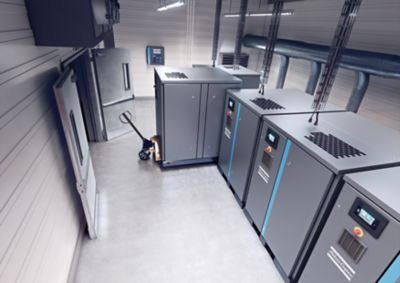Rotary Screw Compressor Parts
1. Inlet Air Filter
These are required for regulatory maintenance and an important component of a compressor. When it comes to oil-injected units, the air filters clean up moisture and oil residue from the opening valve and cooling injection processes. Regular inspection of air filters is crucial for your equipment’s performance.
Air filters are located near the intake valves for the oil-free units. They form the primary defense line from pressurized air impurities and are thus the most common maintenance filters.
2. Rotary Screw Element
Interlocking twin rotors are placed inside lined cylinders wherein their complementary and circulatory rotations occur. As soon as the machine is switched on, rotors will operate, receiving suctioned air from the opening valve. Connected to the compressor’s motors, rotors will start spinning through a wide distribution system of belts, bearings, and the motor drive. Air is sucked and compressed between the rotors while the spinning continues.
The air will be transformed to a fully compressed state once the grooves will reach the finishing of the rotation length. Lastly, the compressed air will be released through the discharge valve into the storage tank.
3. Oil Filter
Oil filters help keep the compressed air’s gas purity clean and intact and ensure proper lubrication and cooling functions of the entire machine. Belt and pulley run in sync with those nestling within the oil separator. Also, since contemporary oil filters have a spin on installation, they are easy to assess and replace.
Most oil filters are equipped with bypass valves that send alerts when oil filters are too jammed or internal operating temperatures are hot. They will allow raw oil to infiltrate the compression chamber but without entering the oil filters.
4. Bearing
Bearings help in reducing friction, balancing part movements, regulating the overall compressor’s temperature. Although there are several bearing nested in crucial places, axial and radial-load bearings are the most important among all. Radial-load bearings help ensure the compressor’s smooth rotations and horizontal circular roller motions without creating noises. Axial bearings keep the complementary and perpendicular spinning of the rollers in load and balanced.
5. Suction valve
Suction valves get triggered by your machine’s programmed stage settings to close and open, which ensures the efficiency of the rotary screw units. As they are engineered to suit different design elements for maximizing airflow, suction valves are available in different configurations. The poppet valve, the ring valve, and the plate valve are the three types of suction valves. Each of them has its distinct concentric layers to ensure ideal air flows for specific operation types.
6. Discharge valve
Being the endpoint of your compressor system, the discharge valves offer a safe and steady release of pure and fresh concentrated air. Whether the air is released into the final storage tank or connected to the air hoses, the discharge valve serves as the critical regulatory agent. Inspecting these valves and their performance is important to avoid any kind of malfunctioning.
7. Compressor motor
It is important to remember that the bigger the motor the better the performance does not always hold true for ensuring optimal productivity. The horsepower generated and maintained by massive motors may court efficiency problems.
You would want to test your motors frequently and check if it’s being productive, thereby gauging the overall performance of your compressor.
8. System control
A compressor’s system and stage control can regulate, monitor, and track the machine’s performance by assessing functionality and checkpoints throughout multiple unit features.
Particular unit designs may have internal sensors for automatically powering off the motor upon the completion of a programmed cycle or when the storage container is saturated. This is a smart technological feature for high-capacity equipment pieces.
9. Oil separator
Some compressor models may need to infuse oil in their chambers for cooling and lubrication, but they also require oil separators to filter and wash off excess oil from compressed air.
High temperatures can be the natural by-product of an equipment’s compressor capabilities. This makes use of oil and coolant fluids necessary for accelerating the machine’s performance. But an oil separator makes sure oil does not get mixed with the final compressed air. Oil separators can be installed when it wears out or you have to optimize your equipment.
10. Gaskets and seals
Gaskets and seals boast an air-tight design to prevent leakage of compressed air. Chamber lining and bearing rings around compression rotors and bearings are as critical as any other big or major compressor parts. As they are oil-injected or self-lubricated, sliding seals reduce natural friction building between rotors.

